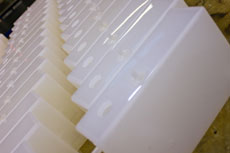all about plastics
Plastikos, from the Greek πλαστικός means “suitable for moulding” and is a word which suggests a material which can be formed into different shapes. But plastics are not a single material. They are a whole group of different materials, with varying properties and applications. They are amazingly varied, from rock hard to soft and flexible. Some are totally colourless, while others can be coloured to any shade at all. Some plastics are resistant to chemicals, others melt at low temperatures. Some can be adapted for use in harsh environments, others are approved for use with foodstuffs. In short, plastics can be used in almost all environments.
In general, plastics can be divided into three groups – stiff or elastic materials, thermoplastics or thermoset plastics, and by whether they are amorphous or semi-crystalline.
A thermoplastic is flexible and mouldable after heating, while thermoset plastics are not mouldable after heating. A thermoplastic, unlike thermoset plastics, can also be melted down to be used in the production of semi-finished plastic items.

A thermoplastic is flexible and mouldable after heating, while thermoset plastics are not mouldable after heating. A thermoplastic, unlike thermoset plastics, can also be melted down to be used in the production of semi-finished plastic items.
Plastics are materials which can be processed in many different ways. They can be refined using methods such as milling, bending, gluing, welding, drilling, turning, polishing or thermoforming, just to give a few examples. The material can be made extremely resistant to cold or heat, can be exceptionally strong yet lightweight and can offer low friction or tolerate exposure to various chemicals. Quite simply, plastics can be used in a huge range of different applications and wide variety of functions – and in many cases replacing other materials, such as metals.












